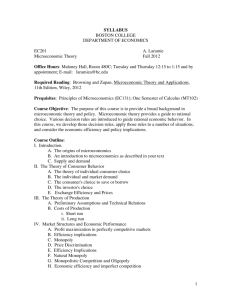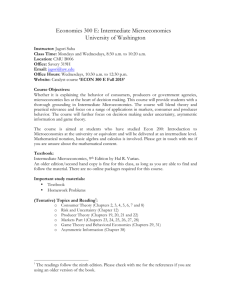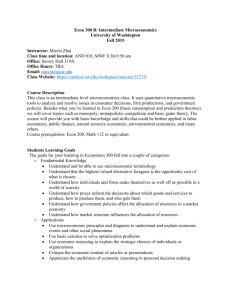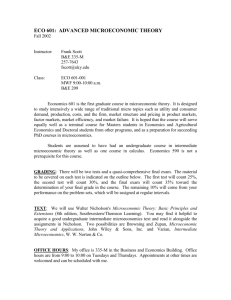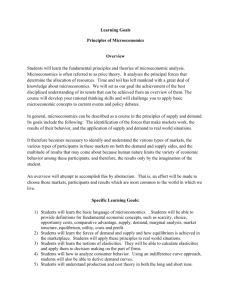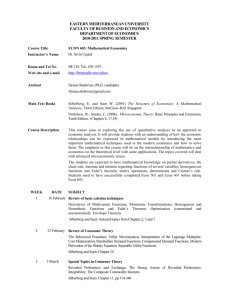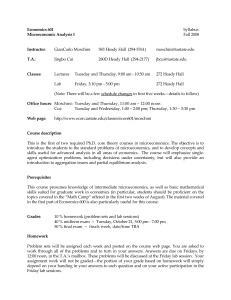MICROECONOMICS I
advertisement
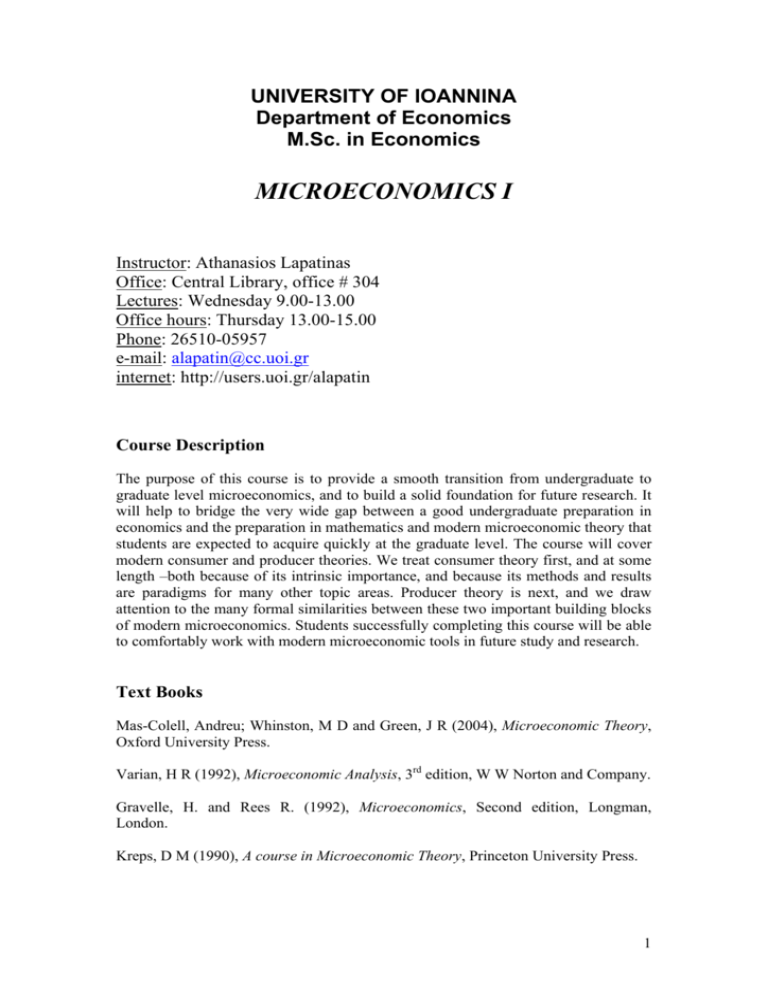
UNIVERSITY OF IOANNINA Department of Economics M.Sc. in Economics MICROECONOMICS I Instructor: Αthanasios Lapatinas Office: Central Library, office # 304 Lectures: Wednesday 9.00-13.00 Office hours: Thursday 13.00-15.00 Phone: 26510-05957 e-mail: alapatin@cc.uoi.gr internet: http://users.uoi.gr/alapatin Course Description The purpose of this course is to provide a smooth transition from undergraduate to graduate level microeconomics, and to build a solid foundation for future research. It will help to bridge the very wide gap between a good undergraduate preparation in economics and the preparation in mathematics and modern microeconomic theory that students are expected to acquire quickly at the graduate level. The course will cover modern consumer and producer theories. We treat consumer theory first, and at some length –both because of its intrinsic importance, and because its methods and results are paradigms for many other topic areas. Producer theory is next, and we draw attention to the many formal similarities between these two important building blocks of modern microeconomics. Students successfully completing this course will be able to comfortably work with modern microeconomic tools in future study and research. Text Books Mas-Colell, Andreu; Whinston, M D and Green, J R (2004), Microeconomic Theory, Oxford University Press. Varian, H R (1992), Microeconomic Analysis, 3rd edition, W W Norton and Company. Gravelle, H. and Rees R. (1992), Microeconomics, Second edition, Longman, London. Kreps, D M (1990), A course in Microeconomic Theory, Princeton University Press. 1 Other useful texts Nicholson, Walter and Snyder, Christopher (2008), Microeconomic Theory: Basic Principles and Extensions, 10th edition, Thompson and South-Western, Sydney, 2008. Hall Varian, Intermediate Microeconomics, 7th edition, W. W. Norton. Friedman, L S (2002), The Microeconomics of Public Policy Analysis, Princeton University Press. Binger, B.R., and Hoffman, E (1988) Microeconomics with Calculus, Scott, Foresman, London. Silberberg, E. and W. Suen (2001), The Structure of Economics: A Mathematical Analysis, McGraw-Hill, New York, NY. Bowles, S. (2004), Microeconomics: Behaviour, Institutions and Evolution, Princeton University Press, Princeton, NJ. Simon, C.P and Blume, L. (1994), Mathematics for Economists, W. W. Norton. Chiang and Wainwright (2005), Fundamental Methods of Mathematical Economics, McGraw-Hill Irwin. Dixit, A.K. (1990), Optimization in Economic Theory, 2nd Ed. Oxford Univ. Press. Rudin, W. (1976), Principles of Mathematical Analysis, 3rd Ed. McGraw-Hill. Evaluation There will be two problem sets, but they are not graded homework assignments and will not be part of the final evaluation. Your final grade is determined mostly by a written final exam. Class policies Please read designated materials before attending the class. You are encouraged to use office hours and emails to discuss problem sets, questions and express your ideas about the course. 2 Schedule • Consumer Theory and Demand - Budget constraints - Preference and utility - Utility maximization - Indirect utility function - Expenditure minimization - Expenditure function - Duality - Envelope Theorems - Mathematics of the response to price changes - The Slutsky Equation Readings: Mas-Colell, A.; Whinston, M D and Green, J R: Chapters 1 to 4; Varian: Chapters 7 & 8 Further readings: Nicholson & Snyder: Chapters 3 to 6, Kreps: Chapter 2; Friedman: Chapters 3 & 4. Dixit: Chapter 2 Silberberg, E. and W. Suen: Consumer Theory Stigler G., (1950), “The Development of Utility Theory”, Journal of Political Economy, 59, October, p.p. 307-327, 373-396 Barten A.P. and Volker Bohm, (1982), “Consumer Theory” in K.J. Arrow and M.D. Intriligator, Handbook of Mathematical Economics, vol. II, NorthHolland Publishing Company, Sections 10 and 11. Deaton A. and J. Muelbauer, (1980), Economics and Consumer Behavior, Cambridge University Press. Section 2.5 Cook P.J., (1972), “A ‘one line’ proof of the Slutsky Equation”, American Economic Review, 62, March. p.139 Fisher F.M. and K. Shell, (1972), The Economic Theory of Price Indices, Academic Press. Sydsaetter K. A. Strorm and P. Berck, (2003), Economist’s Mathematical Mannual, 3rd Ed., Springer-Vergal. Borcherding T.E. and E. Silberberg, (1978), “Shipping the Good Apples Out – The Alchian-Allen Theorem Reconsidered”, Journal of Political Economy, February, pp. 131-138. Rosen S., (1974), “Hedonic Prices and Implicit Markets”, Journal of Political Economy, January-February, p.p. 34-55. 3 Samuelson P.A., (1977), “Complementarity – An Essay on the 40th Anniversary of the Hicks-Allen Revolution in Demand Theory”, Journal of Economic Literature, December, p.p. 1255-1289 • Producer Theory and Supply - Technology / Production functions - Profit maximization and cost minimization - Profit and cost functions - Input demand functions - Duality in production Readings: Mas-Colell, A; Whinston, M D and Green, J R: Chapter 5; Varian Chapters 1 to 5 Further readings: Nicholson & Snyder: Chapters 9, 10 & 11 Silberberg, E. and W. Suen: Chapters 7-9 Clark J.M., “Diminishing Returns”, in Encyclopaedia of the Social Sciences, vol. 5, Crowell-Collier and Macmillan, p.p. 144-146. Douglas P.H., (1948), “Are there laws of production?” American Economic Review, 38, March, p.p. 1-41. Ferguson C.E., (1969), The Neoclassical Theory of Production and Distribution, Cambridge Univ. Press. Fuss M. and D. McFadden, (1980), Production Economics: A Dual Approach to Theory and Application, North-Holland. Shephard R.W., (1978), Theory of Cost and Production Functions, Princeton University Press. Stigler G.J., (1951), “The Division of Labor is Limited by the Extent of the Market”, Journal of Political Economy, 59, June, p.p. 185-193. Sydsaetter K. A. Strorm and P. Berck, (2003), Economist’s Mathematical Mannual, 3rd Ed., Springer-Vergal. chapter 25. Knight H.H., (1921), “Cost of Production and Price over Long and Short Periods”, Journal of Political Economy, 29, April, p.p. 304-335. Samuelson P.A. (1947), Foundations of Economic Analysis, Harvard University Press. 4
